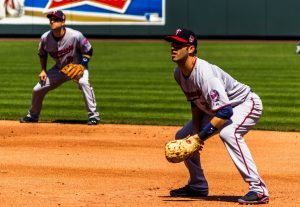Author: Luke Hasskamp
This is the first of a series of articles intended to address some of the interesting intersections between the law and baseball, particularly baseball’s curious exemption from federal and state antitrust laws. More generally, it’s about the struggle between team owners and players since the dawn of professional baseball, and some of the quirks to emerge along the way.
The third part of the series is Baseball Reaches the Supreme Court.
The fourth part of the series is baseball’s antitrust exemption.
The fifth part of the series is Touch ’em all, Curt Flood.
This article starts at the beginning with a fledgling set of teams in the National League in the late 19th century—with team owners trying to turn consistent profits and players beginning to emerge as stars, and the tension between the two.
The trouble started in 1879, when the owners of the teams in the National League agreed on the “reserve clause” which was a provision included in player contracts that effectively bound the player to his team for his entire career. (Here’s an example of such a reserve clause.)
At the time, most National League teams were losing money and faced bleak financial prospects. To curb expenses, the teams agreed on a strategy to keep salaries down: each team would be allowed to “reserve” up to five players for the following season. This meant that no other team could sign a reserved player unless he received permission to do so.
As expected, each team elected to reserve their five best players, i.e., their most expensive players. With no market competing for players’ services, team owners were able to suppress salaries for elite talent and increase profits. Indeed, just two seasons after the adoptions of the reserve clause, most teams had become profitable, the first time that had happened.
Due to this success, the owners saw no reason to limit the reserve clause to the top five players. They steadily increased the reserve limit until, by 1887, a team was permitted to reserve its entire roster, 14 players at the time. 1887 is also the year that the reserve clause became an explicit provision in players’ contracts; until then, it had at first been a secret agreement between the owners and then, after it leaked, simply become a league rule that all players were required to abide by. Importantly (for the owners), the reserve clause crept beyond the National League into other competing leagues that would emerge during that time, including the American Association and the American League, which both agreed to honor National League’s reserve lists.
At this time, the contracts were decidedly one sided. Although teams effectively controlled a player for the entirety of his career, nothing bound the teams to their players, except for their contracts (and virtually all contracts had one-year terms). Any player could be traded or sold at any time, and they could be released on just 10-days’ notice.
John Montgomery Ward became an important early figure in challenges to baseball’s reserve clause. Known as Monte Ward during his playing days, he began his career at 19 as a pitcher for the Providence Grays. In 1879, he went 47–19 with 239 strikeouts and a 2.15 ERA, pitching 587 innings. The following season Ward went 39–24 with 230 strikeouts and a 1.74 ERA pitching 595.0 innings. Ward also has the distinction of pitching the second perfect game in professional history as well as the longest complete game shutout, going 18 innings in a 1-0 win over the Detroit Wolverines 1–0 on August 17, 1882, a record that will never be broken. (He also has a pretty epic baseball card.)
Following an injury to his pitching arm that, remarkably, was not attributed to his workload but to a mishap while sliding, Ward’s performance as a pitcher began to diminish, so the Grays sold him to the New York Gotham before the 1883 season (they were renamed the New York Giants in 1885.) The move was fortuitous for several reasons, including the fact that it enabled Ward to enroll at Columbia Law School, where he graduated in 1885.
Using his legal training, Ward organized and led the first labor union in professional sports, the Brotherhood of Professional Baseball Players. The principal goal of the Brotherhood was to raise player salaries, which had remained stagnant even though baseball’s popularity (and revenues) had risen considerably. A chief target of the Brotherhood’s effort was the reserve clause, which continued to suppress players’ salaries and limit their mobility.
 The Antitrust Attorney Blog
The Antitrust Attorney Blog





